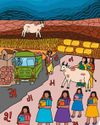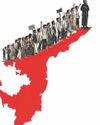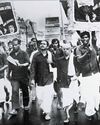The Politics of New Castes
Outlook
|April 01, 2024
With the Prime Minister announcing the poor, women, farmers, and the youths as new caste categories, it would be interesting to see its impact on the upcoming General Elections

ON August 7, 1990, Prime Minister V P Singh, while implementing the recommendations of the Mandal Commission—that included giving 27 per cent reservation to the socially and educationally backward classes—said on the floor of the house: “It is a momentous decision of social justice”. Evoking the legacy of Babasaheb Ambedkar, who tirelessly fought for social and political reservation for the Scheduled Castes (SC) and the Scheduled Tribes (ST), Singh added: “The present decisions are along the same lines, and belong to the tradition of this government’s dedication to the cause of SCs, socially and educationally backward classes and other weaker sections.”
Though this declaration did not cause any immediate stir in the North, Singh was aware of the impending tectonic shift in Indian politics. As the Janata Dal’s (JD) two alliance partners—the Bharatiya Janata Party (BJP) and the Left—were not working in a syncretic manner, Singh, analysts say, wanted to strengthen the social alliance of the Ahir-Jat-Gujjar-andRajput (AJGAR) category that catapulted him to power in 1989. And the best way to do this was to implement the Mandal Commission recommendations.
In the following years, the social alliance of the OBCs and the Dalits, especially across Uttar Pradesh and Bihar, not only changed the fate of politics in India—with the exit of the Congress from both states—it also gave birth to the Kamandal politics that the BJP leveraged to consolidate all the Hindu castes.
Denne historien er fra April 01, 2024-utgaven av Outlook.
Abonner på Magzter GOLD for å få tilgang til tusenvis av kuraterte premiumhistorier og over 9000 magasiner og aviser.
Allerede abonnent? Logg på
FLERE HISTORIER FRA Outlook

Outlook
The Big Blind Spot
Caste boundaries still shape social relations in Tamil Nadu-a state long rooted in self-respect politics
8 mins
December 11, 2025

Outlook
Jat Yamla Pagla Deewana
Dharmendra's tenderness revealed itself without any threats to his masculinity. He adapted himself throughout his 65-year-long career as both a product and creature of the times he lived through
5 mins
December 11, 2025

Outlook
Fairytale of a Fallow Land
Hope Bihar can once again be that impossibly noisy village in Phanishwar Nath Renu's Parti Parikatha-divided, yes, but still capable of insisting that rights are not favours and development is more than a slogan shouted from a stage
14 mins
December 11, 2025

Outlook
The Lesser Daughters of the Goddess
The Dravidian movement waged an ideological war against the devadasi system. As former devadasis lead a new wave of resistance, the practice is quietly sustained by caste, poverty, superstition and inherited ritual
2 mins
December 11, 2025

Outlook
The Meaning of Mariadhai
After a hundred years, what has happened to the idea of self-respect in contemporary Tamil society?
5 mins
December 11, 2025

Outlook
When the State is the Killer
The war on drugs continues to be a war on the poor
5 mins
December 11, 2025

Outlook
We Are Intellectuals
A senior law officer argued in the Supreme Court that \"intellectuals\" could be more dangerous than \"ground-level terrorists\"
5 mins
December 11, 2025

Outlook
An Equal Stage
The Dravidian Movement used novels, plays, films and even politics to spread its ideology
12 mins
December 11, 2025

Outlook
The Dignity in Self-Respect
How Periyar and the Self-Respect Movement took shape in Tamil Nadu and why the state has done better than the rest of the country on many social, civil and public parameters
5 mins
December 11, 2025

Outlook
When Sukumaar Met Elakkiya
Self-respect marriage remains a force of socio-political change even a century later
7 mins
December 11, 2025
Listen
Translate
Change font size

